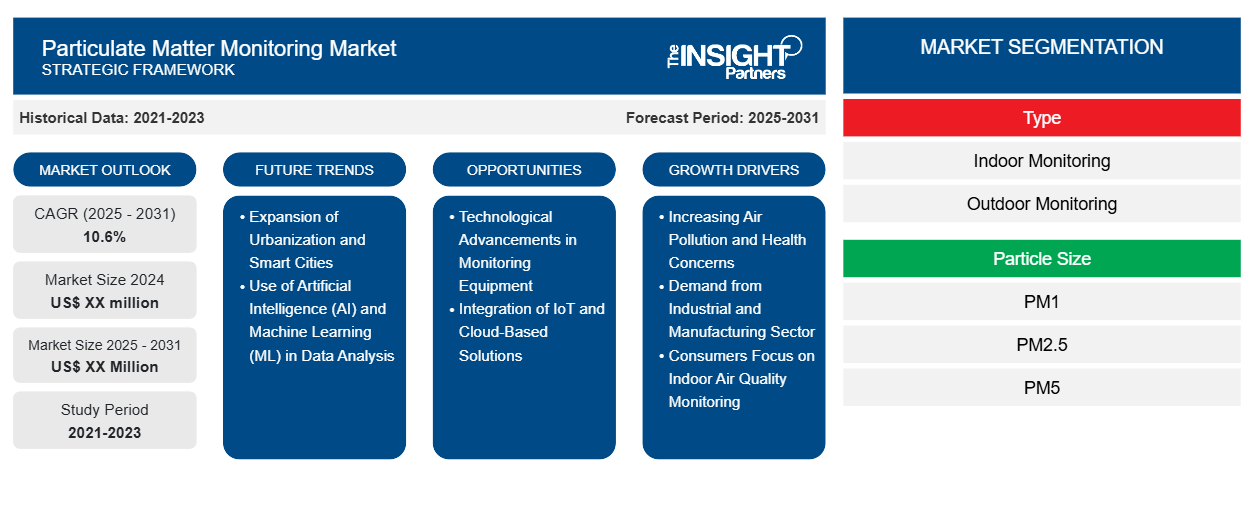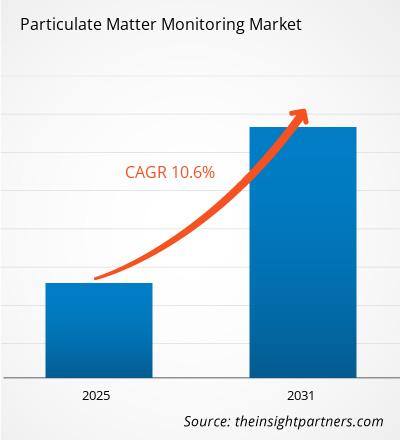The Particulate Matter Monitoring Market is expected to register a CAGR of 10.6% from 2025 to 2031, with a market size expanding from US$ XX million in 2024 to US$ XX Million by 2031.
The report is segmented by Type (Indoor Monitoring, Outdoor Monitoring); Particle Size (PM1, PM2.5, PM5, PM10); Technology (Light Scattering, Beta-Attenuation, Gravimetric, Opacity, Others); Application (Process Industries, Ambient Air Monitoring, Indoor Air Monitoring, Healthcare, Others). The report offers the value in USD for the above analysis and segments
Purpose of the Report
The report Particulate Matter Monitoring Market by The Insight Partners aims to describe the present landscape and future growth, top driving factors, challenges, and opportunities. This will provide insights to various business stakeholders, such as:
- Technology Providers/Manufacturers: To understand the evolving market dynamics and know the potential growth opportunities, enabling them to make informed strategic decisions.
- Investors: To conduct a comprehensive trend analysis regarding the market growth rate, market financial projections, and opportunities that exist across the value chain.
- Regulatory bodies: To regulate policies and police activities in the market with the aim of minimizing abuse, preserving investor trust and confidence, and upholding the integrity and stability of the market.
Particulate Matter Monitoring Market Segmentation
Type
- Indoor Monitoring
- Outdoor Monitoring
Particle Size
- PM1
- PM2.5
- PM5
- PM10
Technology
- Light Scattering
- Beta-Attenuation
- Gravimetric
- Opacity
Application
- Process Industries
- Ambient Air Monitoring
- Indoor Air Monitoring
- Healthcare
You will get customization on any report - free of charge - including parts of this report, or country-level analysis, Excel Data pack, as well as avail great offers and discounts for start-ups & universities
Particulate Matter Monitoring Market: Strategic Insights

-
Get Top Key Market Trends of this report.This FREE sample will include data analysis, ranging from market trends to estimates and forecasts.
Particulate Matter Monitoring Market Growth Drivers
- Increasing Air Pollution and Health Concerns: The rise in air pollution levels, particularly in urban and industrial areas, is a significant driver of the particulate matter (PM) monitoring market. Airborne particles like PM2.5 (particles smaller than 2.5 micrometers) and PM10 (particles smaller than 10 micrometers) have been linked to serious health issues such as respiratory diseases, cardiovascular conditions, and lung cancer. The World Health Organization (WHO) and various health agencies have highlighted the dangerous health implications of long-term exposure to these fine particulates. As governments, NGOs, and public health organizations become more proactive in addressing air quality, regulatory policies on air pollution are being tightened globally. This has increased the demand for air quality monitoring systems that can accurately measure particulate matter concentrations. Local, national, and international environmental regulations are thus pushing industries, cities, and organizations to implement robust monitoring solutions to comply with air quality standards.
- Demand from Industrial and Manufacturing Sector: The industrial and manufacturing sectors, especially those in sectors like energy, chemicals, cement production, mining, and transportation, contribute heavily to particulate matter emissions. As regulations around industrial emissions tighten globally, industries face increasing pressure to monitor and control their emissions effectively. In this context, the particulate matter monitoring market offers significant opportunities for the development of emission control technologies and monitoring solutions tailored to industrial needs. Industrial facilities are increasingly adopting continuous emission monitoring systems (CEMS), which track particulate emissions in real-time, allowing companies to comply with stricter regulations, optimize operational efficiency, and reduce environmental impact. This trend creates a substantial opportunity for market players to provide customized monitoring solutions for the industrial sector.
- Consumers Focus on Indoor Air Quality Monitoring: Another growing opportunity in the particulate matter monitoring market lies in the increasing consumer demand for indoor air quality (IAQ) monitoring. As people become more conscious of the air quality in their homes, workplaces, and schools, there is a surge in demand for personal air quality monitors. These devices, which are often compact and portable, enable consumers to monitor particulate matter levels indoors. The rise of allergy-related health concerns, respiratory conditions, and the COVID-19 pandemic, which has raised awareness about the importance of indoor air quality, has fueled the demand for affordable and user-friendly IAQ monitoring devices. Additionally, smart home integration is driving this trend, with air quality monitoring devices becoming part of home automation systems. This consumer-driven demand offers new opportunities for manufacturers to cater to the home and office air quality monitoring segment.
Particulate Matter Monitoring Market Future Trends
- Expansion of Urbanization and Smart Cities: As urbanization accelerates globally, particularly in emerging markets like India, China, and parts of Africa, cities are facing worsening air quality challenges. With urbanization comes the opportunity for the deployment of smart city initiatives, which aim to improve urban living through technology-driven solutions, including environmental monitoring systems. This presents a significant opportunity for the particulate matter monitoring market to expand, as cities look to install air quality monitoring networks to track PM pollution levels across urban areas. Governments are investing in smart technologies to monitor and control air pollution, and this presents a growing market for particulate matter sensors, monitoring equipment, and data management solutions. Additionally, the deployment of IoT-connected monitoring devices for continuous air quality surveillance in smart cities is an expanding opportunity for both public health improvement and regulatory compliance.
- Use of Artificial Intelligence (AI) and Machine Learning (ML) in Data Analysis: The integration of artificial intelligence (AI) and machine learning (ML) into particulate matter monitoring systems is another significant trend. AI and ML algorithms can analyze vast amounts of air quality data, identifying patterns and correlations that may not be immediately apparent through traditional methods. This capability is particularly useful for predicting pollution levels and understanding the long-term impacts of particulate pollution on public health. Moreover, AI can optimize the placement of sensors, ensuring that the data collected is more representative of overall air quality. This trend towards intelligent, self-learning monitoring systems is expected to improve both the accuracy and effectiveness of particulate matter monitoring, as well as support environmental policy formulation and public health management.
Particulate Matter Monitoring Market Opportunities
- Technological Advancements in Monitoring Equipment: The technological advancements in sensors, IoT (Internet of Things) devices, and data analytics are also driving growth in the particulate matter monitoring market. Low-cost sensors and real-time monitoring solutions have made it possible for organizations, municipalities, and even consumers to measure air quality more easily and affordably. The development of portable air quality monitors, combined with advanced detection technologies like laser-based or optical sensors, has allowed more widespread monitoring, even in remote or hard-to-reach locations. This technological progress is enabling more accurate, real-time data collection and analysis, enhancing the understanding of PM pollution trends and improving decision-making for regulatory compliance and public health management.
- Integration of IoT and Cloud-Based Solutions: A key opportunity in the particulate matter monitoring market is the integration of IoT (Internet of Things) technology with particulate matter sensors. IoT-enabled sensors allow for continuous monitoring and real-time data transmission, often to cloud-based platforms for further analysis. These IoT-based solutions enable stakeholders, such as municipalities, environmental agencies, and industries, to monitor air quality on a large scale across multiple locations. Cloud-based platforms enable data aggregation, storage, and analysis, providing actionable insights into air quality trends and helping stakeholders make informed decisions. The smart sensors integrated with IoT also allow for predictive analytics, identifying air pollution patterns before they reach harmful levels. This trend toward real-time monitoring and data-driven decision-making is expanding the scope of air quality management and enhancing the overall effectiveness of pollution control.
Particulate Matter Monitoring Market Regional Insights
The regional trends and factors influencing the Particulate Matter Monitoring Market throughout the forecast period have been thoroughly explained by the analysts at The Insight Partners. This section also discusses Particulate Matter Monitoring Market segments and geography across North America, Europe, Asia Pacific, Middle East and Africa, and South and Central America.
Particulate Matter Monitoring Market Report Scope
| Report Attribute | Details |
|---|---|
| Market size in 2024 | US$ XX million |
| Market Size by 2031 | US$ XX Million |
| Global CAGR (2025 - 2031) | 10.6% |
| Historical Data | 2021-2023 |
| Forecast period | 2025-2031 |
| Segments Covered |
By Type
|
| Regions and Countries Covered |
North America
|
| Market leaders and key company profiles |
|
Particulate Matter Monitoring Market Players Density: Understanding Its Impact on Business Dynamics
The Particulate Matter Monitoring Market is growing rapidly, driven by increasing end-user demand due to factors such as evolving consumer preferences, technological advancements, and greater awareness of the product's benefits. As demand rises, businesses are expanding their offerings, innovating to meet consumer needs, and capitalizing on emerging trends, which further fuels market growth.

- Get the Particulate Matter Monitoring Market top key players overview
Key Selling Points
- Comprehensive Coverage: The report comprehensively covers the analysis of products, services, types, and end users of the Particulate Matter Monitoring Market, providing a holistic landscape.
- Expert Analysis: The report is compiled based on the in-depth understanding of industry experts and analysts.
- Up-to-date Information: The report assures business relevance due to its coverage of recent information and data trends.
- Customization Options: This report can be customized to cater to specific client requirements and suit the business strategies aptly.
The research report on the Particulate Matter Monitoring Market can, therefore, help spearhead the trail of decoding and understanding the industry scenario and growth prospects. Although there can be a few valid concerns, the overall benefits of this report tend to outweigh the disadvantages.
Frequently Asked Questions
What are the options available for the customization of this report?
What are the deliverable formats of the particulate matter monitoring market report?
What are the future trends of particulate matter monitoring market?
What are the driving factors impacting global particulate matter monitoring market?
What is the expected CAGR of particulate matter monitoring market?
- Historical Analysis (2 Years), Base Year, Forecast (7 Years) with CAGR
- PEST and SWOT Analysis
- Market Size Value / Volume - Global, Regional, Country
- Industry and Competitive Landscape
- Excel Dataset
Recent Reports
Testimonials
Reason to Buy
- Informed Decision-Making
- Understanding Market Dynamics
- Competitive Analysis
- Identifying Emerging Markets
- Customer Insights
- Market Forecasts
- Risk Mitigation
- Boosting Operational Efficiency
- Strategic Planning
- Investment Justification
- Tracking Industry Innovations
- Aligning with Regulatory Trends





















 Get Free Sample For
Get Free Sample For